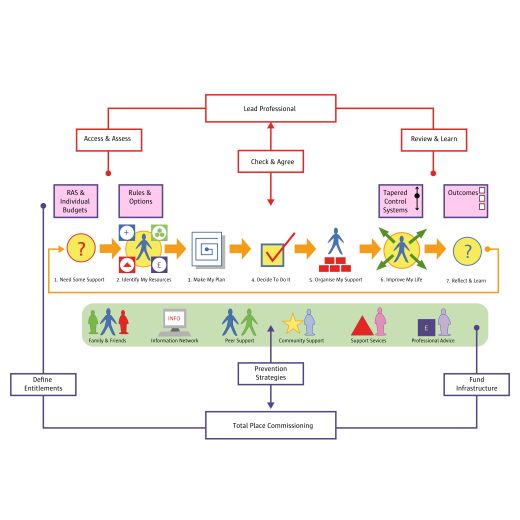Author: Simon Duffy
The Personalisation Model provides a framework for organising public services so that citizen remains in control of their own lives and any support that they need to live that life. It requires radical changes in how services are funded, coordinated and commissioned and the laws that underpin the design of the welfare state.

Background
The term personalisation was popularised by Charles Leadbeater and applied broadly to approaches in public services which focused on increasing the participation, involvement or power of the people using those services. The Personalisation Model was developed by Simon Duffy and the Personalisation in Mental Health group in Yorkshire & Humber. It draws together varied technologies and approaches into one coherent model. It is particularly notable for offering a framework for integrating health and social care support to people with mental health problems.
Concept
The Personalisation Model is a framework for promoting personalised support across public services and the wider community, enabling people to exercise autonomy and control through self-directed support and providing a supporting infrastructure to reduce need and improve outcomes.
It involves:
- Place-Based Commissioning - Statutory partners need to work to develop a shared account of the outcomes that they are trying to achieve within their local communities and develop smart approaches to investing in individuals, communities or services and critically examining their impact.
- Prevention - Funding needs to be invested in ways which reduce need by tackling social injustice and by strengthening capacities. This can mean promoting general well-being, intervening early to prevent needs developing or helping people to better manage their own situation to avoid deterioration and promote recovery.
- Individual Funding - Different forms of individual funding will be necessary to enable people to design and implement personalised support. Formsmay include individual budgets, grants, vouchers or other systems which enable choice, control and flexibility.
- Self-Directed Support - Supports need to be designed by and around the needs of the individual and it must help the individual achieve goals whichare meaningful and valued to the individual.
- Co-production - Professionals need to work as partners with people, recognising the expertise that individuals bring to the achievement of their own outcomes and the meeting of their own needs. Control and support needs to tapered, offering what is necessary with undue interference, but withsufficient support to achieve success.
- Community-Based Support - Self-Directed Support needs to be underpinned by an infrastructure of support which will enable people to makeeffective decisions. This support should be rooted in communities, offering people clear information, peer support and accesses to community services.
- Outcomes-Focus - Supports and systems should be measured by their effectiveness in achieving outcomes - both outcomes valued by individuals andthe broader social outcomes desired by the whole community. Innovation, flexibility and on-going learning are central to the task of enabling citizensand communities to become more competent at achieving improved outcomes.
The publisher is the Centre for Welfare Reform.
Personalisation Model © Simon Duffy 2010.
All Rights Reserved. No part of this paper may be reproduced in any form without permission from the publisher except for the quotation of brief passages in reviews.
